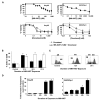Targeting aurora kinase with MK-0457 inhibits ovarian cancer growth
- PMID: 18765535
- PMCID: PMC2766914
- DOI: 10.1158/1078-0432.CCR-07-4922
Targeting aurora kinase with MK-0457 inhibits ovarian cancer growth
Abstract
Purpose: The Aurora kinase family plays pivotal roles in mitotic integrity and cell cycle. We sought to determine the effects of inhibiting Aurora kinase on ovarian cancer growth in an orthotopic mouse model using a small molecule pan-Aurora kinase inhibitor, MK-0457.
Experimental design: We examined cell cycle regulatory effects and ascertained the therapeutic efficacy of Aurora kinase inhibition both alone and combined with docetaxel using both in vitro and in vivo ovarian cancer models.
Results: In vitro cytotoxicity assays with HeyA8 and SKOV3ip1 cells revealed >10-fold greater docetaxel cytotoxicity in combination with MK-0457. After in vivo dose kinetics were determined using phospho-histone H3 status, therapy experiments with the chemosensitive HeyA8 and SKOV3ip1 as well as the chemoresistant HeyA8-MDR and A2780-CP20 models showed that Aurora kinase inhibition alone significantly reduced tumor burden compared with controls (P values<0.01). Combination treatment with docetaxel resulted in significantly improved reduction in tumor growth beyond that afforded by docetaxel alone (P <or= 0.03). Proliferating cell nuclear antigen immunohistochemistry revealed that MK-0457 alone and in combination with docetaxel significantly reduced cellular proliferation (P values<0.001). Compared with controls, treatment with MK-0457 alone and in combination with docetaxel also significantly increased tumor cell apoptosis by approximately 3-fold (P<0.01). Remarkably, compared with docetaxel monotherapy, MK-0457 combined with docetaxel resulted in significantly increased tumor cell apoptosis.
Conclusions: Aurora kinase inhibition significantly reduces tumor burden and cell proliferation and increases tumor cell apoptosis in this preclinical orthotopic model of ovarian cancer. The role of Aurora kinase inhibition in ovarian cancer merits further investigation in clinical trials.
Conflict of interest statement
Figures




Similar articles
-
MK-5108, a highly selective Aurora-A kinase inhibitor, shows antitumor activity alone and in combination with docetaxel.Mol Cancer Ther. 2010 Jan;9(1):157-66. doi: 10.1158/1535-7163.MCT-09-0609. Epub 2010 Jan 6. Mol Cancer Ther. 2010. PMID: 20053775
-
Anticancer activity of the Aurora A kinase inhibitor MK-5108 in non-small-cell lung cancer (NSCLC) in vitro as monotherapy and in combination with chemotherapies.J Cancer Res Clin Oncol. 2014 Jul;140(7):1137-49. doi: 10.1007/s00432-014-1675-6. Epub 2014 Apr 23. J Cancer Res Clin Oncol. 2014. PMID: 24756365 Free PMC article.
-
AT9283, a novel aurora kinase inhibitor, suppresses tumor growth in aggressive B-cell lymphomas.Int J Cancer. 2012 Jun 15;130(12):2997-3005. doi: 10.1002/ijc.26324. Epub 2011 Nov 19. Int J Cancer. 2012. PMID: 21796626
-
Aurora A inhibitor (MLN8237) plus vincristine plus rituximab is synthetic lethal and a potential curative therapy in aggressive B-cell non-Hodgkin lymphoma.Clin Cancer Res. 2012 Apr 15;18(8):2210-9. doi: 10.1158/1078-0432.CCR-11-2413. Epub 2012 Feb 28. Clin Cancer Res. 2012. PMID: 22374334 Free PMC article.
-
Aurora kinase inhibitors--rising stars in cancer therapeutics?Mol Cancer Ther. 2010 Feb;9(2):268-78. doi: 10.1158/1535-7163.MCT-09-0765. Epub 2010 Feb 2. Mol Cancer Ther. 2010. PMID: 20124450 Free PMC article. Review.
Cited by
-
Targeting AURKA in Cancer: molecular mechanisms and opportunities for Cancer therapy.Mol Cancer. 2021 Jan 15;20(1):15. doi: 10.1186/s12943-020-01305-3. Mol Cancer. 2021. PMID: 33451333 Free PMC article. Review.
-
Discovery and exploitation of inhibitor-resistant aurora and polo kinase mutants for the analysis of mitotic networks.J Biol Chem. 2009 Jun 5;284(23):15880-93. doi: 10.1074/jbc.M109.005694. Epub 2009 Apr 9. J Biol Chem. 2009. PMID: 19359241 Free PMC article.
-
Phase I dose escalation study of MK-0457, a novel Aurora kinase inhibitor, in adult patients with advanced solid tumors.Cancer Chemother Pharmacol. 2011 Feb;67(2):305-14. doi: 10.1007/s00280-010-1318-9. Epub 2010 Apr 13. Cancer Chemother Pharmacol. 2011. PMID: 20386909 Free PMC article. Clinical Trial.
-
Single-Cell RNA Sequencing Reveals the Role of Phosphorylation-Related Genes in Hepatocellular Carcinoma Stem Cells.Front Cell Dev Biol. 2022 Jan 4;9:734287. doi: 10.3389/fcell.2021.734287. eCollection 2021. Front Cell Dev Biol. 2022. PMID: 35059393 Free PMC article.
-
Update on aurora kinase inhibitors in gynecologic malignancies.Recent Pat Anticancer Drug Discov. 2008 Nov;3(3):162-77. doi: 10.2174/157489208786242322. Recent Pat Anticancer Drug Discov. 2008. PMID: 18991785 Free PMC article. Review.
References
-
- Harrington EA, Bebbington D, Moore J, et al. VX-680, a potent and selective small-molecule inhibitor of the Aurora kinases, suppresses tumor growth in vivo. Nat Med. 2004;10:262–7. - PubMed
-
- Carvajal RD, Tse A, Schwartz GK. Aurora kinases: new targets for cancer therapy. Clin Cancer Res. 2006;12:6869–75. - PubMed
-
- Katayama H, Brinkley WR, Sen S. TheAurora kinases: role in cell transformation and tumorigenesis. Cancer Metastasis Rev. 2003;22:451–64. - PubMed
-
- Keen N, Taylor S. Aurora-kinase inhibitors as antican cer agents. Nat Rev. 2004;4:927–36. - PubMed
-
- Matthews N, Visintin C, Hartzoulakis B, Jarvis A, Selwood DL. Aurora A and B kinases as targets for cancer: will they be selective for tumors? Exp Rev Anticancer Ther. 2006;6:109–20. - PubMed
Publication types
MeSH terms
Substances
Grants and funding
LinkOut - more resources
Full Text Sources
Medical

